The horsemint is happy. Most of the year the plant is visually nondescript, keeping its presence a secret. But starting around September its bracts turn a lavender/pink brightening every clump of herb and attracting swarms of I’m sure appreciative insects. Like several other plants covered in this newsletter the horsemint seems to be early this year by a few weeks. One cannot drive along a country road and not see it blossoming profusely. I stop so often to take pictures of the annual display I need a bumper sticker that says “I BRAKE FOR HORSEMINT.” Farther north its relatives are called Beebalm and Oswego Tea. They’re used in similar ways. To read more about this seductive mint go here.
While the horsemint is offering a feast for the eyes Kudzu is teasing the nose. The aroma of blossoming Kudzu is unmistakable: It smells just like grape bubble gum. You can catch the aroma of a patch of blossoming Kudzu from hundreds of feet away. All of the Kudzu is edible except for the seeds. The blossoms make a wonderful jelly. Unfortunately the leaves have a texture issue that one just has to accept. And getting starch out of the roots is a Herculean task, not exactly calorie positive. The state of Florida asserts that Kudzu has been eliminated locally but I find it all the time. Perhaps they should pay me to locate it. To read more about Kudzu click here.
Foraging classes this week were in soggy Sarasota and Port Charlotte. It’s not only coastal rain but rain over the interior of Florida that’s flodding out southern areas of the state. In Sarasota normally dry foraging spots were flooded but we managed to rummage around anyway. In fact we did in Sarasota what we always do in Port Charlotte which is visit some of the neighboring residential areas for edibles. That produced a heavily fruiting Cocoplum and a Simpson Stopper, all earlier features in this newsletter. Port Charlotte also produced those fruits along with some late-season ground cherries. There was some Seablite but it was fast fading. It’s my favorite coastal green but very seasonal. At these two classes I managed to distribute some of my last Bunya pine nuts of the season, either for eating or growing. To see my schedule of upcoming classes go here.
The fungal find of the week is not so much edible as medicinal, Ganoderma curtisii. (If you are going to study fungi you have to comes to terms with using Dead Latin in that most mushrooms do not have common names.) The Ganoderma curtisii and the Ganoderma zonatum (the latter found only on palms) are our local versions of the famous medicinal Reishi mushrooms. I personally have not use them but I know a few folks who do. That said I am not an expert on mushrooms by any means. Definitely seek a more qualified opinion than mine. It’s just that I got a second microscope — a more powerful one capable of looking a mushrooms spores — 2000x — so I’ve playing with the new toy and making slides. My discovery this past week is that the bitter, non-edible Sarcodon has spores that look like crumpled bits of translucent green paper. One deadly Amanita spores I looked at resembled slush and snowballs. Fascinating. On a related topic you will read that there are no toxic shelf mushrooms with pores growing on wood. That is mushroom dogma. There is at least one polypore that is toxic, the Hapalopilus nidulans. It can cause kidney dysfunction and brain damage. This information is via herbalist Susan Marynowski of the Gainesville Mushroom Hunters group. Thanks Susan. Fortunately this polypore is easy to identify with a little chemical testing.
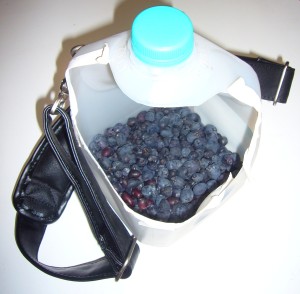
Masking tape around the cut edges reduces the chances of a “paper” cut. Photo and arils picked by Green Deane
Podpcarpus wine is one of my ongoing projects so I am still collecting arils. They are in season now. If you don’t like the idea of making wine the arils can be eaten as is or made into jelly or pies. Just remember the seeds are mildly toxic. We eat the aril only. Collecting them, as with most fruit, requires a little bit of technique (you don’t pick apples and oranges the same way!) If you can look for Podocarpus with large arils. Since you have to go through the same mechanical action with every one you pick selecting larger arils fills the pail faster. You can pick the entire fruit with either hand then use your thumbs to knock the toxic seed off. Or you can hold them in one hand and roll the seed off with the other. Let me repeat: Only the aril is eaten. To have both hand free you can make a berry pail from items you probably have around the house. I use a quarter-cut gallon milk jug and the shoulder strap from a long unused lap top carrying case. Lap top shoulder straps are good because they are – -for me at least — just the right waist length and they have swivel snaps on the end making them easy to work with. I put the entire contraption on like a belt with the jug waist high, perfect for dropping berries into and hands free. As all the Podocarpus arils don’t ripen at the same time I just keep freezing “pickings” until I have enough for whatever project I’m working on.
I’ve always like the word Salmagundi, meaning a hodgepodge. We’ve reached the Salmagundi time of the newsletter. The Florida Herbal Conference 2014 will be held in Deland again this coming February. Susan Weed will be the among featured speakers. And again there is an early bird special for those who sign up before Oct. 31 and use the code EATTHEWEEDS. Not only will I be doing weed walks at the herbal conference but I also be leading weed walks at the Florida Earthskills gathering also in February. Closer to home I will be talking at a Native Plant Society conference in November in Orlando and in Tampa in March there’s a begonia conference I’ll be addressing. Busy. This is a reminder that we discuss edible wild plants all the time on the Green Deane Forum. It’s a friendly, wholesome environment and we even identify some Unknown Flowering Objects now and then. It’s a bit of a challenge but I still read every post and answer my own email. We also have many on-going conversation about herbal applications as well.
And that’s it until next week.
_______________________________________
Even though my foraging videos are for free on the internet some foragers like to have their own copy. My nine DVDs have 15 videos each, from 01 to 135, and come in nine cases each with a picture of yours truly on it. In the process of moving the videos to DVS some of them were enhanced slightly from the version on the Internet. In a few months I hope to have volume 10 available as well. I print and compile the sets myself so if you have any issues I handle it personally. There are no middle men. To learn more about them or to order the DVS click here.

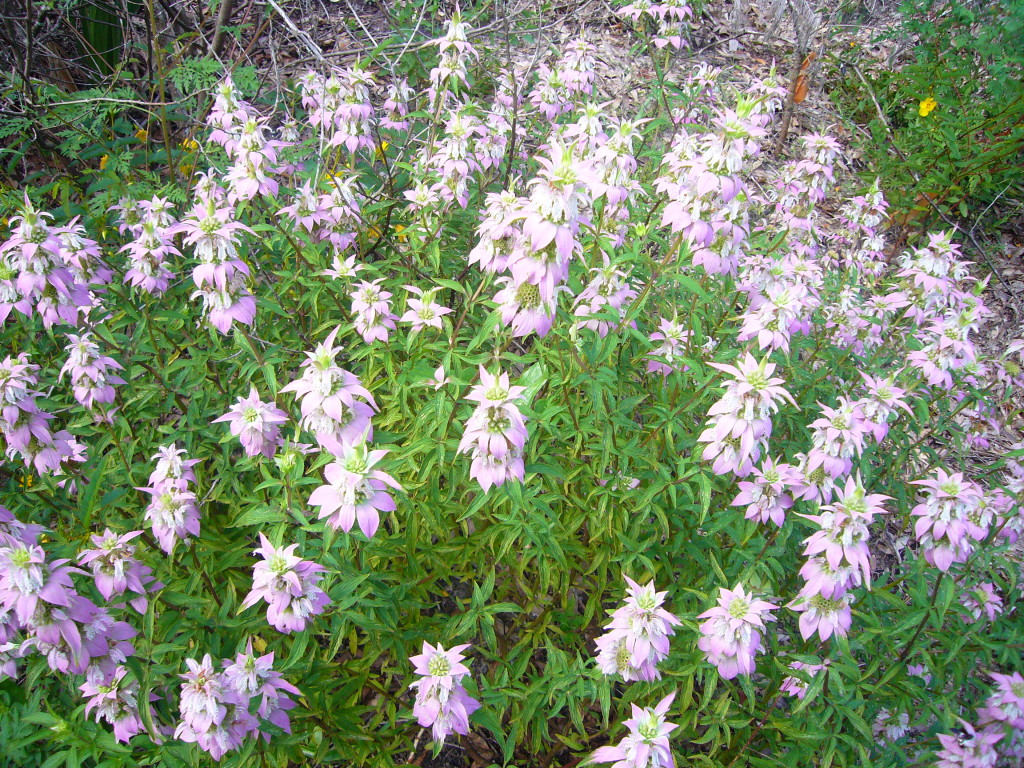
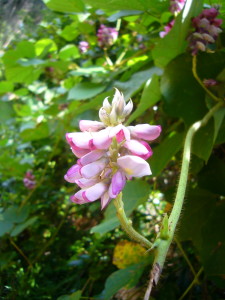
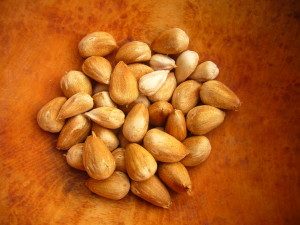
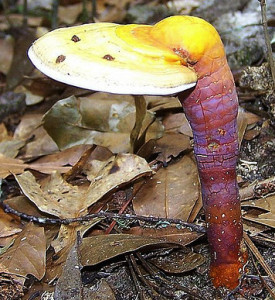
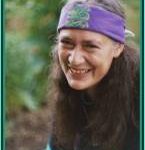


Thanks for the info on the Kudzu; a friend of ours who rides Pinellas Trail always reports smelling something that smells “exactly like grape jelly” when he rides the trail; now we email him your blog, so he can look for and identify patches of Kudzu that may be the source of the aroma.
How do you feel about the edibility of a similarly rampant vine escapee, Mucuna pruriens, sometimes called “velvet bean.” A friend of ours shared some brown velvet pod producing, supposedly edible/medicinal Mucuna pruriens seeds with us, so we grew them this year, but are now afraid to eat them due to conflicting reports of edibility/toxicity of the bean seeds.
Our friend recommends cooking the beans for 20 minutes, and eating 1 pod per day for three weeks, then not eating them for 3 weeks, and repeating the cycle, in order to stimulate production of human growth hormone (to ward off Parkinsons Disease, stimulate production of dopamine, etc.). Do you have any personal experience with the brown fuzzy pod producing Mucuna pruriens? The vine has been very productive, but seems to have invasive potential. If it’s too toxic to eat, then I will have to collect all the existing pods to make sure they don’t reseed next year, pull the root, and just use the vine and leaves for potentially high nitrogen compost. If you have had positive experience with the edibility of the beans, then I will be interested to know at what stage you harvested them, and how you prepared them.
Thanks again for the wealth of information you are so generous to share with all of us who enjoy growing and foraging native, naturalized, and even escaped exotic and agricultural plants found in Florida.
I know little about the plant, unfortunately. I need to look into it.
Wouldn’t it be great if I could have you send me five kudzu seeds for my garden. All expenses paid of course. Tell me what you think. (^_^)
which you are you referring to?
I don’t suppose anyone has some kudzu seeds they want to part with. I would like to grow some in a very large pot to experiment with medicinally. Or a cutting, or If someone could tell me where near palm beach county it grows? I would really appreciate it. Thank you in advance for your help.
hey there dean,
I was wondering how eating wild plants has bettered your health? Have you notice any reduction with getting sick or any extra vitality? Also i remember from some of your videos that you use to live in maine could you recommend anything to try? Thanks a bunch 🙂
Zack
Lewiston, Maine
I could but I don’t visit much any more. You should google Arthur Haines.